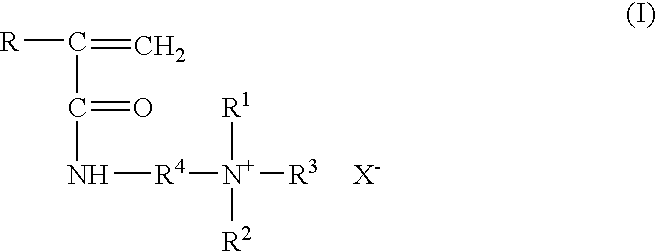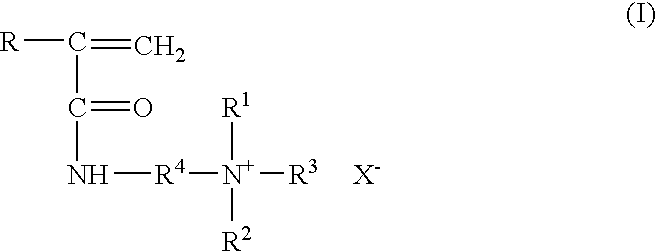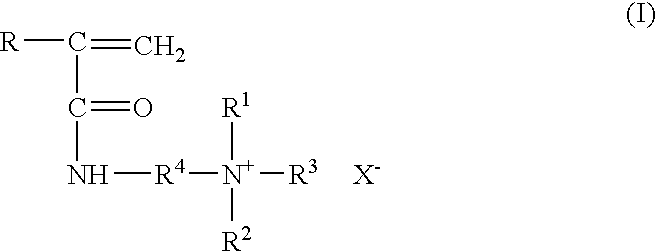Method for inhibiting or controlling inorganic scale formations with copolymers of acrylamide and quaternary ammonium salts
a technology of inorganic scales and copolymers, which is applied in the direction of sealing/packing, cabinets, and well accessories, etc., can solve the problems of brines that may become lost in the reservoir and remain in the formation for a long time, damage to well productivity, and zinc sulfide or iron sulfide scales, etc., to achieve high solubility and improve compatibility
- Summary
- Abstract
- Description
- Claims
- Application Information
AI Technical Summary
Benefits of technology
Problems solved by technology
Method used
Image
Examples
examples
[0040]All percentages expressed herein are in terms of weight percent unless otherwise noted.
examples 1-20
[0041]In each of the Examples below, either 0.5% or 1% (by volume) copolymer or terpolymer was used to treat the ZnBr2 completion brines. For purposes of these examples, the term copolymer or terpolymer shall contain either “PADAC” [poly(acrylamide-co-diallyidimethylammonium chloride)] in a 5 weight percent solution in water or an “AADAC” [a terpolymer of acrylic acid, dimethyldiallylammonium chloride and acrylamide] in a 5 weight percent solution in water. To evaluate the effectiveness of formulated PADAC and AADAC, the following method was applied, and the results obtained are presented in Tables 1, 2 and 3.
[0042]A 3% sodium chloride brine was prepared. Sodium sulfide was added to sodium chloride brine to produce sulfur ion. A ZnBr2 brine (either CaBr2 / ZnBr2 or CaCl2 / CaBr2 / ZnBr2) was then prepared. ZnS scale inhibitor was added to the ZnBr2 brine. Sodium chloride brine and ZnBr2 brine was mixed at a 1:1 volumetric ratio in a glass jar. The glass jar was placed in a 180° F. water b...
examples 21-24
[0046]A zinc bromide based brine having a density of 17.6 pound / gallon (ppg) was formulated from calcium chloride, calcium bromide, zinc bromide and fresh water by blending standard 15.1 ppg CaCl2 / CaBr2 fluid with 19.2 ppg CaBr2 / ZnBr2 fluid. The brine was composed of 35.12 wt. percent of ZnBr2, 29.76 wt. percent of CaBr2, 6.76 wt. percent of CaCl2 and 28.42 wt. percent of water. Further, the weight percent of each individual ion in the brine was 10.19 Zn, 8.39 Ca, 4.28 Cl and 48.73 Br.
[0047]Compatibility of a copolymer of acrylamidopropyltrimonium chloride and acrylamide in 1 weight percent solution in water, a product of Ciba Specialty Chemicals, was then tested with the zinc bromide brine. The copolymer was added to the zinc brine. The brine was then mixed with a 3% sodium chloride solution at a 1:1 volumetric ratio in a glass jar. The glass jar was placed in the water bath of 180° F. Compatibility vs. time was noted. For compatibility test at 300° F., the glass jar was placed in ...
PUM
| Property | Measurement | Unit |
|---|---|---|
| density | aaaaa | aaaaa |
| molar ratios | aaaaa | aaaaa |
| molar ratios | aaaaa | aaaaa |
Abstract
Description
Claims
Application Information
 Login to View More
Login to View More - R&D
- Intellectual Property
- Life Sciences
- Materials
- Tech Scout
- Unparalleled Data Quality
- Higher Quality Content
- 60% Fewer Hallucinations
Browse by: Latest US Patents, China's latest patents, Technical Efficacy Thesaurus, Application Domain, Technology Topic, Popular Technical Reports.
© 2025 PatSnap. All rights reserved.Legal|Privacy policy|Modern Slavery Act Transparency Statement|Sitemap|About US| Contact US: help@patsnap.com



